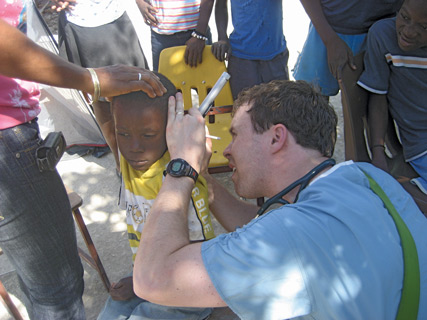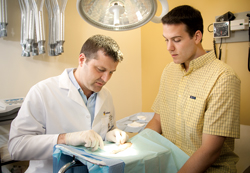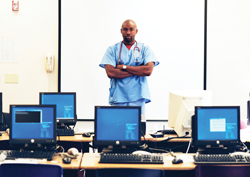Volunteer internists help to rebuild Haiti
Physicians in Haiti face a new set of challenges as they stem the spread of infectious diseases and restore medical care to a country that had little before a devastating earthquake struck.
Katy A. Close, ACP Member, was on vacation in the Bahamas on Jan. 12 when a 7.0 earthquake struck Haiti. Eight days later, when she arrived at Hospital Albert Schweitzer in the city of Deschapelles, about 90 miles west of the epicenter in Port-au-Prince, “There were people everywhere with unfixed fractures and open wounds. People were all over the floor; you had to step over them.”
Dr. Close, a clinical associate professor at the University of South Carolina School of Medicine who spends three months a year volunteering at Albert Schweitzer, helped tend to the hundreds of victims that descended on the rural hospital. Conditions in Haiti have since improved, but physician volunteers now face a new set of challenges as they try to stem the spread of epidemic and infectious diseases and restore decent medical care in a country that was struggling before the disaster.

“In the first phase, it was predominantly a surgical emergency, but now we are shifting into medical issues,” said Arthur M. Fournier, ACP Member, who arrived in Port-au-Prince two days after the quake.
Dr. Fournier is co-founder of the nonprofit Project Medishare, which, with support from the University of Miami Global Institute, has been sending teams of physicians and nurses to Haiti since 1994.
“A lot of crush injuries are leading to renal failure … we've had four cases of tetanus at our hospital [in Haiti] and we're bracing for infectious diarrhea,” said Dr. Fournier, who when not providing disaster relief is also professor and vice chairman of the department of family medicine and community health and the associate dean for community health affairs at the University of Miami's Miller School of Medicine.
Internist volunteers have shifted focus accordingly. First responders pitched in as needed, providing basic wound and nursing care, for example. Physicians are now moving to provide chronic care, which in Haiti is part medicine and part social work due to the extreme poverty.
“The people we treat, some have never had homes,” said Dr. Close. “And homes are typically the size of a kitchen, with the floor and a bed and that's it. You can't give them the same advice you'd give here.”
In the months ahead, expect to see “continuation of chronic disease, worsening of infectious diseases, more gender violence and tremendous psychiatric trauma,” said Evan Lyon, MD, a hospitalist at Brigham and Women's Hospital in Boston and a volunteer in Haiti for the past 13 years through the nonprofit organization Partners in Health. Those problems existed prior to the earthquake, he said, but the disaster has made a bad situation worse.
Rural hospitals overwhelmed
Dealing with the huge influx of patients was a major challenge even for hospitals that were far enough away from the epicenter of the earthquake to escape major damage. At one point, Albert Schweitzer, which serves the impoverished Artibonite Valley in central Haiti, was housing 500 patients in a facility built for 150.
“The quake really knocked them off their feet, not so much in damage to infrastructure but because it was one of the few institutions with functioning facilities anywhere in the environs of Port-au-Prince,” said Steven Williams, ACP Member, an internist at Allegheny General Hospital in Pittsburgh, Pa., who has volunteered at Albert Schweitzer every year since 1990. “They initially had only two surgeons working dawn to night until volunteers arrived.”

Similarly, Hospital Sacré Coeur, a 72-bed tertiary facility about 70 miles north of the capital run by the Center for the Rural Development of Milot (CRUDEM) Foundation, was inundated with patients. Volunteers set up six army tents with 40 cots in each to accommodate approximately 400 victims of the earthquake, said Michael Fitzgerald, MD, an internist in Syracuse, N.Y., who has volunteered at Sacré Coeur for the past five years.
By the time Dr. Fitzgerald arrived, along with his wife, a nurse, and his daughter, a pediatric nurse practitioner, volunteer orthopedic surgeons were there to deal with the influx. “They were just doing amputation after amputation,” he recalled.
“We've been like a MASH unit,” said Richard B. Perry, MACP, a retired internist in Potomac, Md., who has volunteered at Sacré Coeur for seven years and serves on its board of directors. “Helicopters came throughout the day bringing patients from Port-au-Prince and other small tent hospitals that didn't have the facilities that we had as an established hospital.”
When Dr. Perry arrived in Haiti about three weeks after the earthquake, surgeries had subsided and volunteers were concentrating on wound care and teaching people how to use crutches. “We're morphing into a chronic care, post-quake care hospital and also a refugee camp in that many patients have relatives and we have had to provide food and water for them.”
With so many amputations performed, providing prostheses was another challenge, said Dr. Perry. It was difficult to get patients up and walking on crutches because they were so weak from not eating for days and from chronic malnutrition.
Dr. Close, who normally cares for patients with diabetes and other chronic diseases, said the influx also caused “collateral damage” by pushing aside patients who weren't injured in the disaster.
“A woman came into the hospital with a headache and she couldn't be seen because there were too many other people there,” Dr. Close said. “But by the time she came back two weeks later with her headache she had a seizure and died right in front of me.”
Poor sanitation breeds disease
Sanitation was never good in Haiti—raw sewage ran down the streets when it rained, for example—but the earthquake has made conditions much worse, setting the stage for disease, said Dr. Williams. If action isn't taken on providing more stable housing before the impending rainy season, tent cities will turn into mud piles and “sewage will be everywhere,” he said.
According to the World Health Organization, 45% of Haiti's population did not have access to safe water in 2009, while 83% lived in unsanitary conditions. Since the earthquake, water has been contaminated by sewage, increasing the risk of epidemics of typhoid fever and hepatitis A and E, said the WHO in its report “Public Health Risk Assessment and Interventions: Earthquake—Haiti,” compiled in response to the disaster.
In addition, the WHO report warns, communicable diseases (measles, diphtheria, pertussis and acute respiratory infections) are likely to thrive in the overcrowded settlements filled with displaced earthquake victims. Inadequate living conditions also increase people's risk for malaria and dengue fever.
“A million displaced people living in fields with no place to defecate will breed disease,” said Dr. Williams, who anticipates seeing more cases of typhoid and malaria as well as gastroenteritis and dysentery in the coming months. “Before you even think about rebuilding the infrastructure of the hospitals, you have to think about shelter, sanitation and potable water.”
Functioning in such an environment isn't easy and physicians must be willing to take on a wide variety of tasks, said Dr. Perry. For example, medical volunteers at Sacré Coeur had to help dig latrines because waste products were thrown out into the open.
Similarly, Dr. Fournier and his colleagues with Project Medishare emptied out waste buckets before portable toilets were installed at a tent field hospital in Cap-Haïtien, where the group runs a family medicine training program. For patients needing intravenous infusions, the team tied IV bags to a clothesline using rubber gloves because there were no IV poles on hand.
“You have to improvise,” he said. “You have to be not so stuffy that you can't do things outside of your pay grade.”
To ward off outbreaks of disease, physicians are focusing on vaccinating as many people as possible and doing what they can to make conditions more sanitary, said Dr. Perry. Many Haitians are not immunized against diseases such as measles, mumps and meningococcal disease, he said.
Wound infections will also be a problem for “months to come,” said Casey M. McMillan, ACP Member, a med-peds hospitalist at The Regional Medical Center in Orangeburg, S.C., who spent a week at a hospital in Les Cayes, about four hours from the capital. And mental health problems are also pervasive in the earthquake's aftermath, according to Dr. Perry.
“People are sad. They stare at you in a vacant way,” he said. He recalled one woman who was crying all the time. She had lost a leg and was taken to the hospital by helicopter without knowing anything about the fate of her six children.
“One of the Haitian physicians said to me that he is worried there will be a lot of suicides over the next months,” he said. “We are going to need mental health volunteers and counselors on an ongoing basis.”
Rebuilding the infrastructure
In addition to managing emerging diseases and other health issues, nonprofit medical groups are assisting with rebuilding the medical infrastructure and helping restore, or even improve, medical care in the country. The ultimate goal of some major U.S. aid groups is to re-establish a system led and managed by Haitians.
“Our [U.S. physicians] ongoing presence should be related to training,” said Dr. Fournier. “I would like to see U.S. medical schools chip in and help resuscitate the schools and participate in the training of Haitian [medical] residents.”
Haiti has long suffered from a “brain drain” as many graduating doctors choose to do their residencies in the U.S., Canada or Europe, said Dr. Fournier. The earthquake has made retaining physicians even more challenging.
“Who could blame someone who had the opportunity to leave?” he said. “On the other hand, it's a tremendous drain on the Haitian workforce.”
Partners in Health and its sister organization, Zanmi Lasante (“Partners in Health” in Haitian Creole), the largest health care provider in rural Haiti, have established a partnership with University Hospital in Port-au-Prince to help rebuild the Hôpital de l’Université d’état d’Haiti, the country's largest public hospital, as a major center for patient care and physician training. Dr. Lyon, who has worked with Zanmi Lasante for the past decade, acts as a middleman between foreign aid groups and Haitian medical personnel who turned the badly damaged hospital into an emergency surgical center after the earthquake.
Meanwhile, Project Medishare is working with University Hospital's Hospital de la Paix in Port-au-Prince by establishing a surgical training program. The group is training surgeons to repair clefts and treat burns and has initiated a pediatric neurosurgery training program, said Dr. Fournier.
“It [rebuilding] will take small organizations like ours with grassroots there that are willing to make a commitment in partnership with Haitian people,” said Dr. Fournier. “You have to have a coordinated plan and hopefully people won't get donor fatigue and forget about this when cameras are no longer shining on these poor people who are suffering.”
Partners in Health's short-term goal is to establish decent care at Hôpital de l’Université d’état d’Haiti, which was dysfunctional and underfunded before the quake, said Dr. Lyon. Long-term, the aim is to help the hospital train new doctors and establish a Haitian medical faculty. A formal plan is not yet in place but one idea is to establish exchanges with major U.S. medical schools.
But while re-establishing a Haitian-run medical system is a noble goal, it may be destined to failure.
“The U.S. should stay involved in running Haiti's hospitals,” said Dr. Williams, citing Haiti's widespread government corruption and the magnitude of the destruction. “[Haiti] has never functioned properly and it's never had a functioning government,” he explained. “So when you talk about turning things over to the Haitians, it's a great idea but there's a good chance it will be plundered [by the government].”
And even with extensive international aid, rebuilding is a daunting prospect in light of Haiti's pre-existing conditions.
“In the short term we are working in collaboration with the Haitians to raise the standard of care, including basic materials to work,” said Dr. Lyon. “Rehabilitation back to the baseline of a poor public health system is a five- to 10-year project.”





